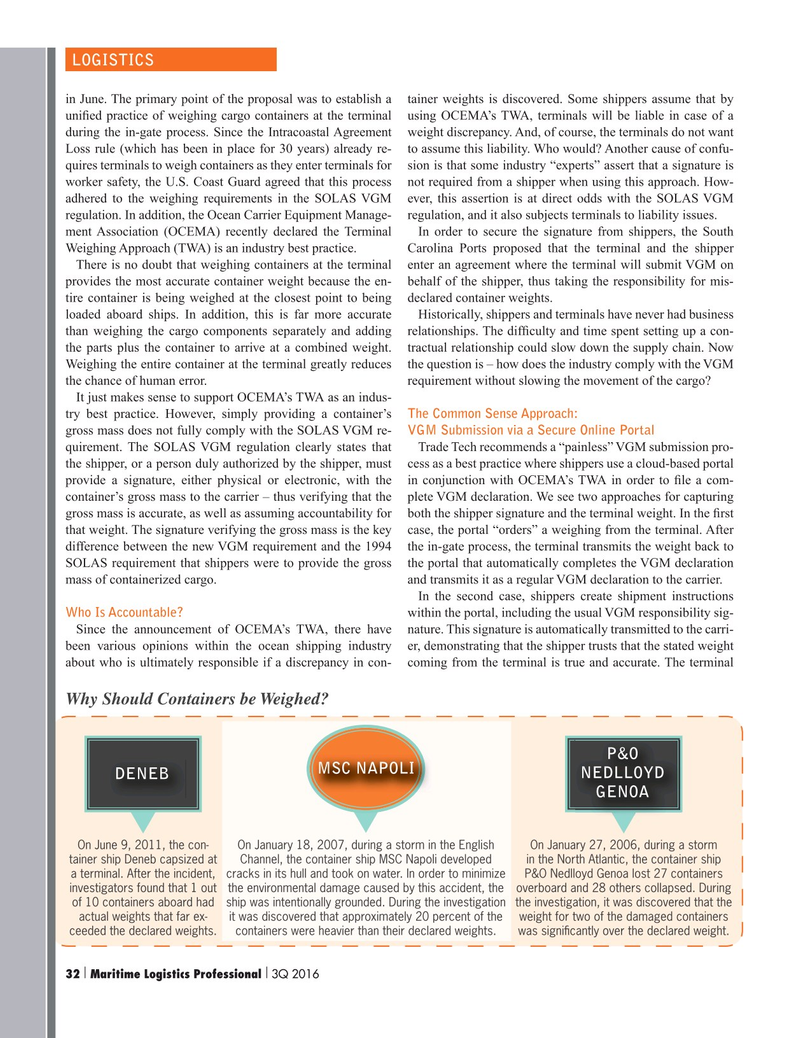
Page 32: of Maritime Logistics Professional Magazine (Q3 2016)
Shipbuilding, Repair & Maintenance
Read this page in Pdf, Flash or Html5 edition of Q3 2016 Maritime Logistics Professional Magazine
LOGISTICS in June. The primary point of the proposal was to establish a tainer weights is discovered. Some shippers assume that by uni? ed practice of weighing cargo containers at the terminal using OCEMA’s TWA, terminals will be liable in case of a during the in-gate process. Since the Intracoastal Agreement weight discrepancy. And, of course, the terminals do not want
Loss rule (which has been in place for 30 years) already re- to assume this liability. Who would? Another cause of confu- quires terminals to weigh containers as they enter terminals for sion is that some industry “experts” assert that a signature is worker safety, the U.S. Coast Guard agreed that this process not required from a shipper when using this approach. How- adhered to the weighing requirements in the SOLAS VGM ever, this assertion is at direct odds with the SOLAS VGM regulation. In addition, the Ocean Carrier Equipment Manage- regulation, and it also subjects terminals to liability issues.
ment Association (OCEMA) recently declared the Terminal In order to secure the signature from shippers, the South
Weighing Approach (TWA) is an industry best practice. Carolina Ports proposed that the terminal and the shipper
There is no doubt that weighing containers at the terminal enter an agreement where the terminal will submit VGM on provides the most accurate container weight because the en- behalf of the shipper, thus taking the responsibility for mis- tire container is being weighed at the closest point to being declared container weights. loaded aboard ships. In addition, this is far more accurate Historically, shippers and terminals have never had business than weighing the cargo components separately and adding relationships. The dif? culty and time spent setting up a con- the parts plus the container to arrive at a combined weight. tractual relationship could slow down the supply chain. Now
Weighing the entire container at the terminal greatly reduces the question is – how does the industry comply with the VGM the chance of human error. requirement without slowing the movement of the cargo?
It just makes sense to support OCEMA’s TWA as an indus- try best practice. However, simply providing a container’s The Common Sense Approach: gross mass does not fully comply with the SOLAS VGM re- VGM Submission via a Secure Online Portal quirement. The SOLAS VGM regulation clearly states that Trade Tech recommends a “painless” VGM submission pro- the shipper, or a person duly authorized by the shipper, must cess as a best practice where shippers use a cloud-based portal provide a signature, either physical or electronic, with the in conjunction with OCEMA’s TWA in order to ? le a com- container’s gross mass to the carrier – thus verifying that the plete VGM declaration. We see two approaches for capturing gross mass is accurate, as well as assuming accountability for both the shipper signature and the terminal weight. In the ? rst that weight. The signature verifying the gross mass is the key case, the portal “orders” a weighing from the terminal. After difference between the new VGM requirement and the 1994 the in-gate process, the terminal transmits the weight back to
SOLAS requirement that shippers were to provide the gross the portal that automatically completes the VGM declaration mass of containerized cargo. and transmits it as a regular VGM declaration to the carrier.
In the second case, shippers create shipment instructions
Who Is Accountable? within the portal, including the usual VGM responsibility sig-
Since the announcement of OCEMA’s TWA, there have nature. This signature is automatically transmitted to the carri- been various opinions within the ocean shipping industry er, demonstrating that the shipper trusts that the stated weight about who is ultimately responsible if a discrepancy in con- coming from the terminal is true and accurate. The terminal
Why Should Containers be Weighed?
P&O
MSC NAPOLI
DENEB NEDLLOYD
GENOA
On June 9, 2011, the con- On January 18, 2007, during a storm in the English On January 27, 2006, during a storm tainer ship Deneb capsized at Channel, the container ship MSC Napoli developed in the North Atlantic, the container ship a terminal. After the incident, cracks in its hull and took on water. In order to minimize P&O Nedlloyd Genoa lost 27 containers investigators found that 1 out the environmental damage caused by this accident, the overboard and 28 others collapsed. During of 10 containers aboard had ship was intentionally grounded. During the investigation the investigation, it was discovered that the actual weights that far ex- it was discovered that approximately 20 percent of the weight for two of the damaged containers ceeded the declared weights. containers were heavier than their declared weights. was signi? cantly over the declared weight. 32 Maritime Logistics Professional 3Q 2016| | 18-33 Q3 MP2016.indd 32 8/17/2016 11:33:53 AM

 31
31

 33
33
